(完整版)高中语法:it用法
- 格式:docx
- 大小:10.33 KB
- 文档页数:3
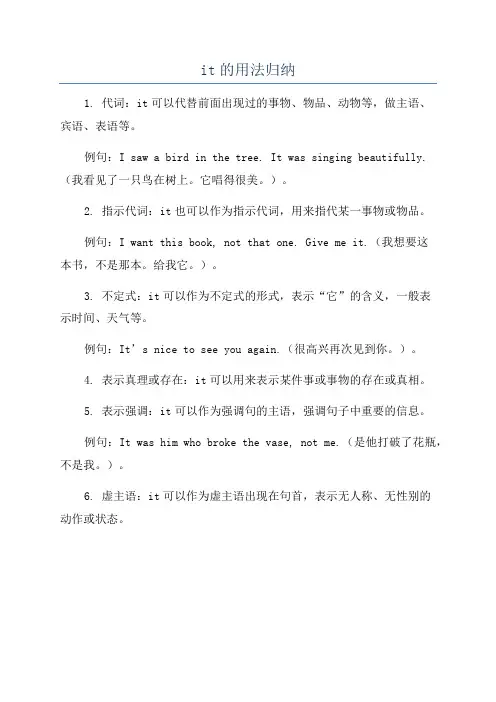
it的用法归纳
1. 代词:it可以代替前面出现过的事物、物品、动物等,做主语、
宾语、表语等。
例句:I saw a bird in the tree. It was singing beautifully. (我看见了一只鸟在树上。
它唱得很美。
)。
2. 指示代词:it也可以作为指示代词,用来指代某一事物或物品。
例句:I want this book, not that one. Give me it.(我想要这
本书,不是那本。
给我它。
)。
3. 不定式:it可以作为不定式的形式,表示“它”的含义,一般表
示时间、天气等。
例句:It’s nice to see you again.(很高兴再次见到你。
)。
4. 表示真理或存在:it可以用来表示某件事或事物的存在或真相。
5. 表示强调:it可以作为强调句的主语,强调句子中重要的信息。
例句:It was him who broke the vase, not me.(是他打破了花瓶,不是我。
)。
6. 虚主语:it可以作为虚主语出现在句首,表示无人称、无性别的
动作或状态。
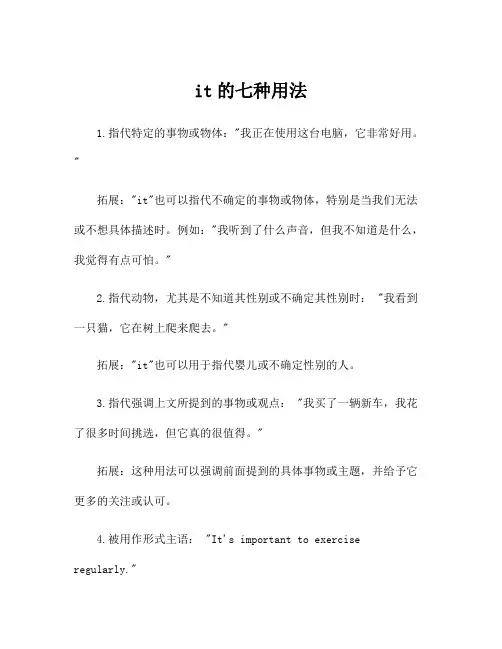
it的七种用法1.指代特定的事物或物体:"我正在使用这台电脑,它非常好用。
"拓展:"it"也可以指代不确定的事物或物体,特别是当我们无法或不想具体描述时。
例如:"我听到了什么声音,但我不知道是什么,我觉得有点可怕。
"2.指代动物,尤其是不知道其性别或不确定其性别时: "我看到一只猫,它在树上爬来爬去。
"拓展:"it"也可以用于指代婴儿或不确定性别的人。
3.指代强调上文所提到的事物或观点: "我买了一辆新车,我花了很多时间挑选,但它真的很值得。
"拓展:这种用法可以强调前面提到的具体事物或主题,并给予它更多的关注或认可。
4.被用作形式主语: "It's important to exercise regularly."拓展:在某些句子中,"it"可以用作形式主语,代表主语部分的内容,尤其是当真正的主语是以后出现时。
5.引导强调句: "It was John who broke the vase."拓展:在强调句中,"it"被用作形式主语,而真正的主语将被放置在句子的后部,以便强调。
6.用于指示时间、天气和环境条件: "It's raining outside."拓展:"it"在描述天气、时间或条件时,常用于英语中,例如:"It's getting late." "It's hot today."7.在某些习语中,表示状态或情感: "I'm over it." (我已经度过了这个困境)拓展:在某些习语或俚语中,"it"用于表示情感、状态或体验,并在一定程度上代表所描述的特定情况。
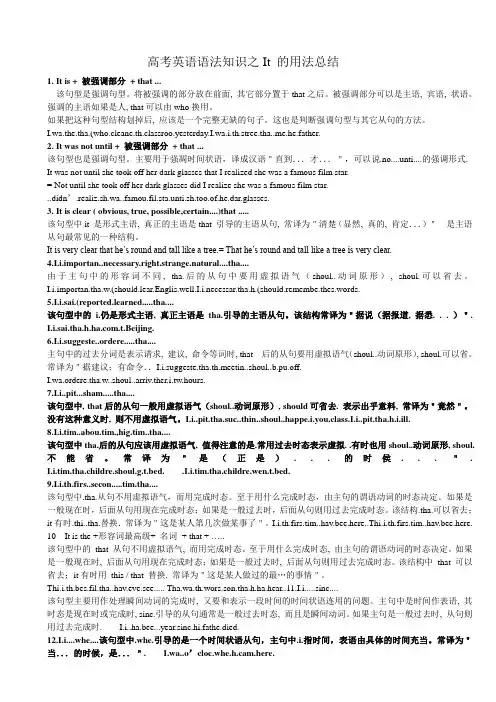
高考英语语法知识之It 的用法总结1. It is + 被强调部分+ that ...该句型是强调句型。
将被强调的部分放在前面, 其它部分置于that之后。
被强调部分可以是主语, 宾语, 状语。
强调的主语如果是人, that可以由who换用。
如果把这种句型结构划掉后, 应该是一个完整无缺的句子。
这也是判断强调句型与其它从句的方法。
I.wa.the.tha.(who.cleane.th.classroo.yesterday.I.wa.i.th.stree.tha..me.he.father.2. It was not until + 被强调部分+ that ...该句型也是强调句型。
主要用于强凋时间状语,译成汉语"直到...才...",可以说.no....unti....的强调形式. It was not until she took off her dark glasses that I realized she was a famous film star.= Not until she took off her dark glasses did I realize she was a famous film star...didn’.realiz.sh.wa..famou.fil.sta.unti.sh.too.of.he.dar.glasses.3. It is clear ( obvious, true, possible,certain....)that .....该句型中it 是形式主语, 真正的主语是that 引导的主语从句, 常译为"清楚(显然, 真的, 肯定...)"是主语从句最常见的一种结构。
It is very clear that he’s round and tall like a tree.= That he’s round and tall like a tree is very clear.4.I.i.importan..necessary.right.strange.natural....tha....由于主句中的形容词不同, tha.后的从句中要用虚拟语气(shoul..动词原形), shoul.可以省去。
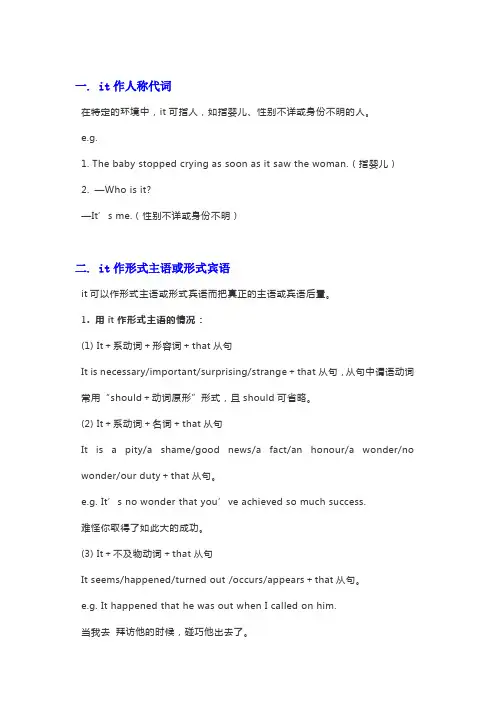
一. it作人称代词在特定的环境中,it可指人,如指婴儿、性别不详或身份不明的人。
e.g.1. The baby stopped crying as soon as it saw the woman.(指婴儿)2. —Who is it?—It’s me.(性别不详或身份不明)二. it作形式主语或形式宾语it可以作形式主语或形式宾语而把真正的主语或宾语后置。
1. 用it作形式主语的情况:(1) It+系动词+形容词+that从句It is necessary/important/surprising/strange+that从句,从句中谓语动词常用“should+动词原形”形式,且should可省略。
(2) It+系动词+名词+that从句It is a pity/a shame/good news/a fact/an honour/a wonder/no wonder/our duty+that从句。
e.g. It’s no wonder that you’ve achieved so much success.难怪你取得了如此大的成功。
(3) It+不及物动词+that从句It seems/happened/turned out /occurs/appears+that从句。
e.g. It happened that he was out when I called on him.当我去拜访他的时候,碰巧他出去了。
(4) It+系动词+过去分词+that从句It is said /reported/ announced/ believed/ thought/ well known/ hoped/ pointed out/ found out/ suggested/ ordered/ advised/ requested/ insisted/ required/ demanded+that从句。
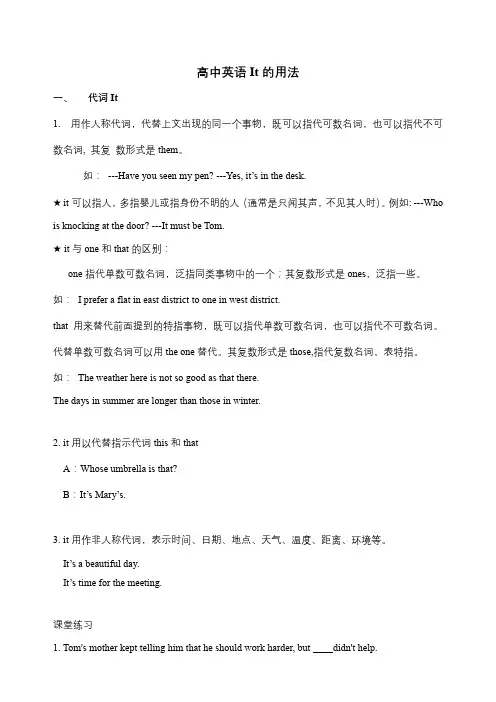
高中英语It的用法一、代词It1.用作人称代词,代替上文出现的同一个事物,既可以指代可数名词,也可以指代不可数名词, 其复数形式是them。
如:---Have you seen my pen? ---Yes, it’s in the desk.★ it可以指人,多指婴儿或指身份不明的人(通常是只闻其声,不见其人时)。
例如: ---Who is knocking at the door? ---It must be Tom.★ it与one和that的区别:one指代单数可数名词,泛指同类事物中的一个;其复数形式是ones,泛指一些。
如:I prefer a flat in east district to one in west district.that用来替代前面提到的特指事物,既可以指代单数可数名词,也可以指代不可数名词。
代替单数可数名词可以用the one替代。
其复数形式是those,指代复数名词,表特指。
如:The weather here is not so good as that there.The days in summer are longer than those in winter.2. it用以代替指示代词this和thatA:Whose umbrella is that?B:It’s Mary’s.3. it用作非人称代词,表示时间、日期、地点、天气、温度、距离、环境等。
It’s a beautiful day.It’s time for the meeting.课堂练习1. Tom's mother kept telling him that he should work harder, but ____didn't help.A. heB. whichC. sheD. it2. We’ve been looking at the houses but haven’t found ____ we like yet.A. oneB. onesC. itD. them3. The Parkers bought a new house but ____ will need a lot of work before they can move in.A. theyB. itC. oneD. which4. I was disappointed with the film. I had expected ________to be much better.A. thatB. thisC. oneD. it5. ---Do you like ___ here?---Oh, yes. The air, the weather, the way of life. Everything is so nice.A. thisB. theseC. thatD. it6. We need a new cupboard for the kitchen. So Peter made ____ from some wood we had.A. itB. oneC. himselfD. another答案:DABDDB二、引导词it1. it用作形式主语It is uncertain whether he can come to Jenny’s birthday party or not.It’s a pity that you missed the exciting football match.It remains a question whether he will come or not.It is reported that 16 people were killed in the earthquake.It happened that I was out when he called.It’s necessary for the young to master two foreign language.It is no use arguing about the matter with him.2. it用作形式宾语动词+形式宾语+宾语补足语+真正的宾语。
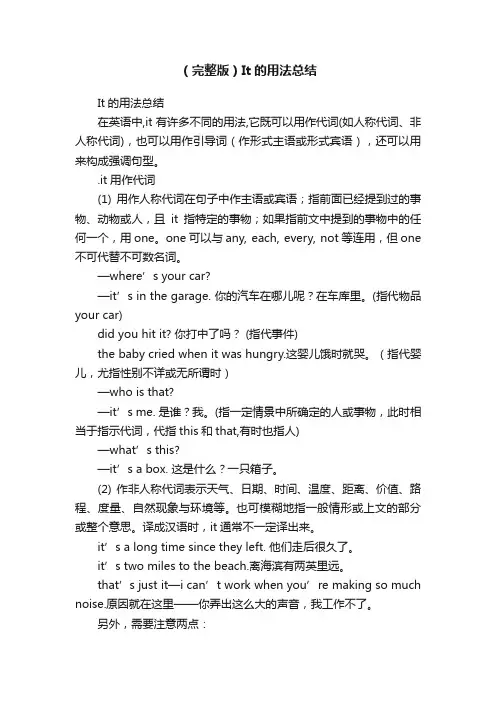
(完整版)It的用法总结It的用法总结在英语中,it有许多不同的用法,它既可以用作代词(如人称代词、非人称代词),也可以用作引导词(作形式主语或形式宾语),还可以用来构成强调句型。
.it用作代词(1) 用作人称代词在句子中作主语或宾语;指前面已经提到过的事物、动物或人,且it指特定的事物;如果指前文中提到的事物中的任何一个,用one。
one可以与any, each, every, not等连用,但one 不可代替不可数名词。
—where’s your car?—it’s in the garage. 你的汽车在哪儿呢?在车库里。
(指代物品your car)did you hit it? 你打中了吗? (指代事件)the baby cried when it was hungry.这婴儿饿时就哭。
(指代婴儿,尤指性别不详或无所谓时)—who is that?—it’s me. 是谁?我。
(指一定情景中所确定的人或事物,此时相当于指示代词,代指this和that,有时也指人)—what’s this?—it’s a box. 这是什么?一只箱子。
(2) 作非人称代词表示天气、日期、时间、温度、距离、价值、路程、度量、自然现象与环境等。
也可模糊地指一般情形或上文的部分或整个意思。
译成汉语时,it通常不一定译出来。
it’s a long time since they left. 他们走后很久了。
it’s two miles to the beach.离海滨有两英里远。
that’s just it—i can’t work when you’re making so much noise.原因就在这里——你弄出这么大的声音,我工作不了。
另外,需要注意两点:(1)“it’s time…”后面可以接不定式和介词短语表示“是做……的时候了”。
如:it’s time for supper. it’s time to have supper.(2) “it’s time…”后面还可以接一个从句,但是从句中的谓语动词一定要用过去式即虚拟语气,如:it’s time we had lunch.是我们吃饭的时候了。
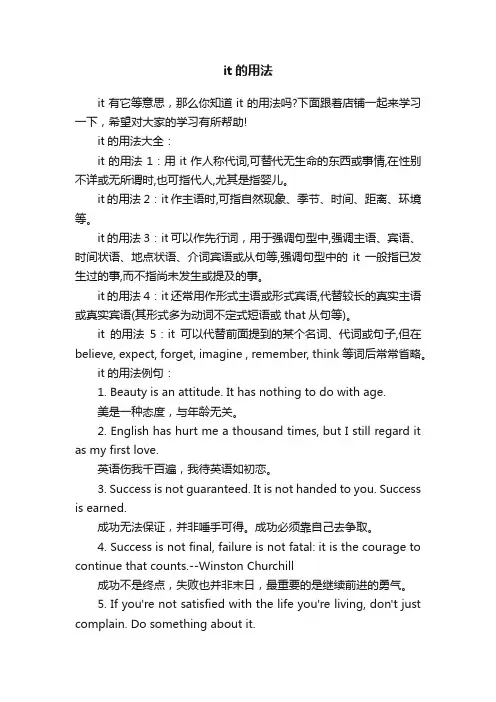
it的用法it有它等意思,那么你知道it的用法吗?下面跟着店铺一起来学习一下,希望对大家的学习有所帮助!it的用法大全:it的用法1:用it作人称代词,可替代无生命的东西或事情,在性别不详或无所谓时,也可指代人,尤其是指婴儿。
it的用法2:it作主语时,可指自然现象、季节、时间、距离、环境等。
it的用法3:it可以作先行词,用于强调句型中,强调主语、宾语、时间状语、地点状语、介词宾语或从句等,强调句型中的it一般指已发生过的事,而不指尚未发生或提及的事。
it的用法4:it还常用作形式主语或形式宾语,代替较长的真实主语或真实宾语(其形式多为动词不定式短语或that从句等)。
it的用法5:it可以代替前面提到的某个名词、代词或句子,但在believe, expect, forget, imagine , remember, think等词后常常省略。
it的用法例句:1. Beauty is an attitude. It has nothing to do with age.美是一种态度,与年龄无关。
2. English has hurt me a thousand times, but I still regard it as my first love.英语伤我千百遍,我待英语如初恋。
3. Success is not guaranteed. It is not handed to you. Success is earned.成功无法保证,并非唾手可得。
成功必须靠自己去争取。
4. Success is not final, failure is not fatal: it is the courage to continue that counts.--Winston Churchill成功不是终点,失败也并非末日,最重要的是继续前进的勇气。
5. If you're not satisfied with the life you're living, don't just complain. Do something about it.对于现况的不满,不能只是抱怨,要有勇气作出改变。
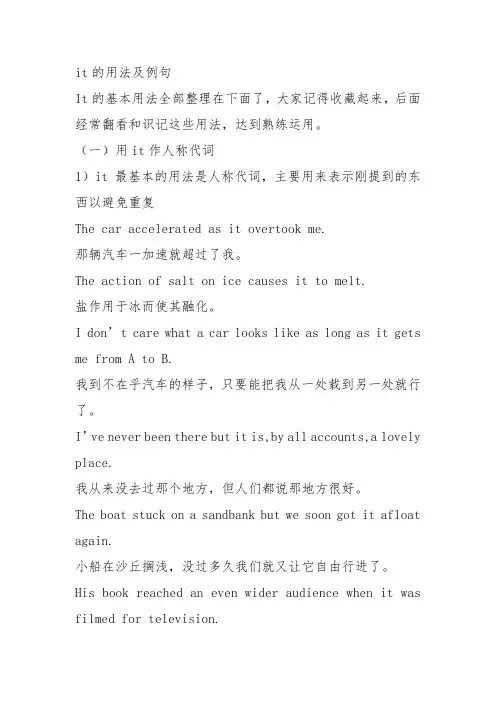
it的用法及例句It的基本用法全部整理在下面了,大家记得收藏起来,后面经常翻看和识记这些用法,达到熟练运用。
(一)用it作人称代词1)it最基本的用法是人称代词,主要用来表示刚提到的东西以避免重复The car accelerated as it overtook me.那辆汽车一加速就超过了我。
The action of salt on ice causes it to melt.盐作用于冰而使其融化。
I don’t care what a car looks like as long as it gets me from A to B.我到不在乎汽车的样子,只要能把我从一处载到另一处就行了。
I’ve never been there but it is,by all accounts,a lovely place.我从来没去过那个地方,但人们都说那地方很好。
The boat stuck on a sandbank but we soon got it afloat again.小船在沙丘搁浅,没过多久我们就又让它自由行进了。
His book reached an even wider audience when it was filmed for television.他的书拍成电视以后,受众范围更广了。
2)也可代表抽象的事物It was acclaimed as a great discovery.它被誉为一次伟大的发现。
Will you pay cash or should I charge it to your account ? 您愿意付现金还是计入您的账?Communication technologies are far from equal when it comes to conveying the truth.交流的技术在传递事实时差别是很大的。
3)也可指动物或未知性别的婴儿- Is this your dog ?- No,it isn’t.Her baby is due next month,she hopes it will be a boy. 她怀的孩子应该下月出生,她希望是个男孩儿。
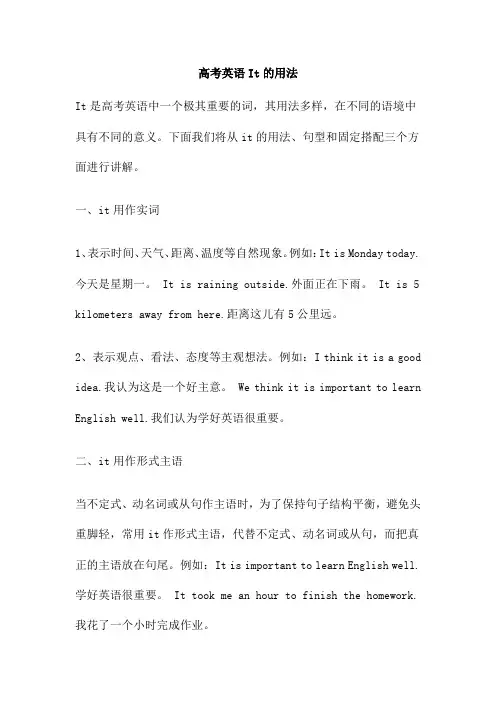
高考英语It的用法It是高考英语中一个极其重要的词,其用法多样,在不同的语境中具有不同的意义。
下面我们将从it的用法、句型和固定搭配三个方面进行讲解。
一、it用作实词1、表示时间、天气、距离、温度等自然现象。
例如:It is Monday today.今天是星期一。
It is raining outside.外面正在下雨。
It is 5 kilometers away from here.距离这儿有5公里远。
2、表示观点、看法、态度等主观想法。
例如:I think it is a good idea.我认为这是一个好主意。
We think it is important to learn English well.我们认为学好英语很重要。
二、it用作形式主语当不定式、动名词或从句作主语时,为了保持句子结构平衡,避免头重脚轻,常用it作形式主语,代替不定式、动名词或从句,而把真正的主语放在句尾。
例如:It is important to learn English well.学好英语很重要。
It took me an hour to finish the homework.我花了一个小时完成作业。
三、it用作形式宾语当不定式、动名词或从句作宾语时,为了保持句子结构平衡,避免头重脚轻,常用it作形式宾语,代替不定式、动名词或从句,而把真正的宾语放在句尾。
例如:I think it is important to learn English well.我认为学好英语很重要。
He found it hard to learn English well.他发现学好英语很难。
四、it用于强调句型中强调句型是英语中一个重要的句型,用于突出强调某个成分,特别是主语、宾语和状语等。
在强调句型中,it没有实际意义,只是起到引导作用。
例如:It is I who am the best student in my class.我是班里最好的学生。
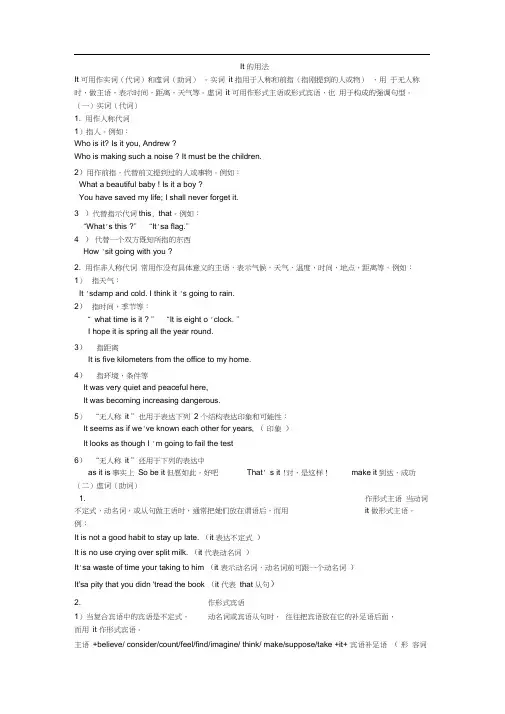
It 的用法It 可用作实词(代词)和虚词(助词)。
实词it 指用于人称和前指(指刚提到的人或物),用于无人称时,做主语,表示时间,距离,天气等。
虚词it 可用作形式主语或形式宾语,也用于构成的强调句型。
(一)实词(代词)1. 用作人称代词1)指人。
例如:Who is it? Is it you, Andrew ?Who is making such a noise ? It must be the children.2)用作前指,代替前文提到过的人或事物。
例如:What a beautiful baby ! Is it a boy ?You have saved my life; I shall never forget it.3 )代替指示代词this, that。
例如:“What's this ?” “It'sa flag.”4 )代替一个双方既知所指的东西How 'sit going with you ?2. 用作非人称代词常用作没有具体意义的主语,表示气候,天气,温度,时间,地点,距离等。
例如:1)指天气:It 'sdamp and cold. I think it 's going to rain.2)指时间,季节等:“ what time is it ? ” “It is eight o 'clock. ”I hope it is spring all the year round.3)指距离It is five kilometers from the office to my home.4)指环境,条件等It was very quiet and peaceful here,It was becoming increasing dangerous.5)“无人称it ”也用于表达下列2 个结构表达印象和可能性:It seems as if we've known each other for years, (印象)It looks as though I 'm going to fail the test6)“无人称it ”还用于下列的表达中as it is事实上So be it但愿如此,好吧That' s it !对,是这样!make it到达,成功(二)虚词(助词)1. 作形式主语当动词不定式,动名词,或从句做主语时,通常把她们放在谓语后,而用it 做形式主语。
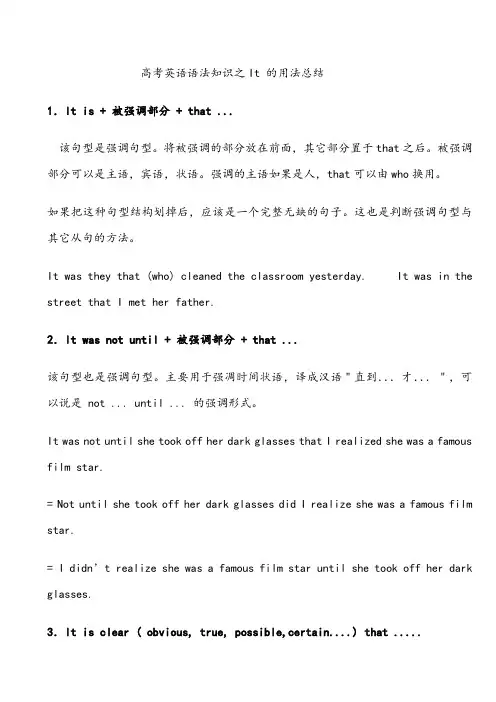
高考英语语法知识之It 的用法总结1.It is + 被强调部分 + that ...该句型是强调句型。
将被强调的部分放在前面,其它部分置于that之后。
被强调部分可以是主语,宾语,状语。
强调的主语如果是人,that可以由who换用。
如果把这种句型结构划掉后,应该是一个完整无缺的句子。
这也是判断强调句型与其它从句的方法。
It was they that (who) cleaned the classroom yesterday. It was in the street that I met her father.2.It was not until + 被强调部分 + that ...该句型也是强调句型。
主要用于强凋时间状语,译成汉语"直到...才...",可以说是 not ... until ... 的强调形式。
It was not until she took off her dark glasses that I realized she was a famous film star.= Not until she took off her dark glasses did I realize she was a famous film star.= I didn’t realize she was a famous film star until she took off her dark glasses.3.It is clear ( obvious, true, possible,certain....) that .....该句型中it 是形式主语,真正的主语是that 引导的主语从句,常译为"清楚(显然,真的,肯定...)"是主语从句最常见的一种结构。
It is very clear that he’s round and tall like a tree.= That he’s round and tall like a tree is very clear.4. It is important ( necessary, right, strange, natural...) that ...由于主句中的形容词不同,that 后的从句中要用虚拟语气(should + 动词原形),should 可以省去。
高中阶段It常用句型解析及运用一、It作形式主语1.It 代替不定式,常用于以下结构:It+ be+ adj./ n. +( for sb )to do sth;It+ be+ adj. +of sb to do sthIt takes +sb+一段时间+ to do①It is important for us to master a foreign language.对于我们来说,掌握一门外语是十分重要的。
②It is very kind of you to help me with my English.你帮我学英语,真是太好了。
③It will take about two days to drive to Shanghai.开车去上海大约要两天的时间。
2.It代替动名词,常用于以下句型中:It is no use doing sth. 做……没有用。
It is no good doing sth. 做……没好处It is fun doing sth. 做……有趣①It’s no use crying over spilt milk.覆水难收。
②It’s no good eating some fast food.吃快餐是没有好处的。
③It’s great fun jumping into the swimming pool in summer.夏天跳进游泳池里游泳是件有趣的事。
3.It代替that从句,常用于以下句型中:It be +adj./ n. +that从句It be +过去分词+ that 从句It seems / appears / happens / turns out that 从句It ourred to sb+ that从句①I don’t know the restaurant, but it’s said that it’s quite a good one.我不知道这家饭馆,但听说相当不错。
高中英语it用法总结
it可用作人称代词、指示代词、先行词及引导词等。
可代表前文已提到过的一件事物。
用作指示代词时,常用来指人。
用作虚词时无指代性。
人称代词it,是第三人称单数中性
代表前文已提到过的一件事物。
当说话者不清楚或无必要知道说话对象的性别时,也可用it来表示。
it可用来指代团体。
扩展资料
it用以代替指示代词this, that。
指示代词it,常用以指人。
虚义it无指代性,常用作没有具体意义的主语,出现于表示天气、气候、温度、时间、地点、距离等意义的句子中。
it也常用来表示一般的笼统的情况。
It句型背诵一.It 做形式主语●to do 做真正的主语1. 我很方便和他取得联系。
It is convenient for me to get in touch with him.2. 你那样做是很愚蠢的。
It is stupid of you to do so.3. 我们听到那消息很惊讶。
It was amazing to us to hear the news4. 修长城花费了成千上万人很多年的时间。
It took thousands of people many years to build the Greatwall.●doing做真正主语5. 你和他理论是没有用的。
It is no use your arguing with him.6. 覆水难收It is no good crying over spilt milk.7. 雨天爬山真是有趣。
It is great fun climbing mountains on raining days.8这项工作值得做It is worthwhile doing the work.It is worthwhile to do the work.●that 做真正主语9. 他整天责备别人是不足为奇。
It is no wonder that he scolds others all day long.10. 据信他在国外学习/ 要去国外学习/ 去了国外学习。
It is believed that he is studying abroad / to go abroad for study/ has gone abroad for study. He is believed to be studying abroad/ to go abroad for study/ to have gone abroad for study.11. 我突然想起我忘了锁门。
it用法归纳与总结
1. IT可以作为名词使用,表示信息技术(Information Technology),也可以指代IT行业或IT部门。
例如:I work
in IT.(我在IT行业工作)
2. IT可以作为代词使用,表示指示事物、情况或观点。
例如:
I don't understand it.(我不明白它)
3. IT可以作为形容词使用,表示指示事物或情况与信息技术
相关。
例如:IT industry(IT行业)
4. IT可以作为副词使用,表示指示方式、情况或程度。
例如:He did it quickly.(他做得很快)
5. IT可以与其他词组合成固定搭配,表示特定意义。
例如:
IT infrastructure(IT基础设施)、IT skills(IT技能)
总结起来,IT通常作为名词使用,表示信息技术,同时也可
根据上下文的不同作为代词、形容词或副词使用。
在IT领域,常用的短语和搭配也有特定的含义。
It 的用法
It 可用作实词(代词)和虚词(助词)。
实词it 指用于人称和前指(指刚提到的人或物),用于无人称时,做主语,表示时间,距离,天气等。
虚词it 可用作形式主语或形式宾语,也用于构成的强调句型。
(一)实词(代词)
1. 用作人称代词
1)指人。
例如:
Who is it? Is it you, Andrew ?
Who is making such a noise ? It must be the children.
2)用作前指,代替前文提到过的人或事物。
例如:
What a beautiful baby ! Is it a boy ?
You have saved my life; I shall never forget it.
3 )代替指示代词this, that。
例如:
“What's this ?” “It'sa flag.”
4 )代替一个双方既知所指的东西
How 'sit going with you ?
2. 用作非人称代词常用作没有具体意义的主语,表示气候,天气,温度,时间,地点,距离等。
例如:1)指天气:
It 'sdamp and cold. I think it 's going to rain.
2)指时间,季节等:
“ what time is it ? ” “It is eight o 'clock. ”
I hope it is spring all the year round.
3)指距离
It is five kilometers from the office to my home.
4)指环境,条件等
It was very quiet and peaceful here,
It was becoming increasing dangerous.
5)“无人称it ”也用于表达下列2 个结构表达印象和可能性:
It seems as if we've known each other for years, (印象)
It looks as though I 'm going to fail the test
6)“无人称it ”还用于下列的表达中
as it is事实上So be it但愿如此,好吧That' s it !对,是这样!make it到达,成功(二)虚词(助词)
1. 作形式主语当动词不定式,动名词,或从句做主语时,通常把她们放在谓语后,而用it 做形式主语。
例:
It is not a good habit to stay up late. (it 表达不定式)
It is no use crying over split milk. (it 代表动名词)
It'sa waste of time your taking to him (it 表示动名词,动名词前可跟一个动名词)
It'sa pity that you didn 'tread the book (it 代表that从句)
2. 作形式宾语
1)当复合宾语中的宾语是不定式,动名词或宾语从句时,往往把宾语放在它的补足语后面,
而用it 作形式宾语。
主语+believe/ consider/count/feel/find/imagine/ think/ make/suppose/take +it+ 宾语补足语(形容词
/名词/介词短语)+ 不定式/动名词/that +从句
You must find it exciting working here. (it 代表动名词)
I made it my business to settle this problem. (it 代表不定式)
2)在下列动词后,用it 充当形式宾语,后接从句。
主语+would appreciate/can make + it+ if 从句
(表示礼貌的请求或建议)
I would appreciate it if you could come to my birthday party.
You can make it if you hurry.
㈢主语+like/dislike/love/hate + it+ when/that+ 从句
(表示喜欢或不喜欢)
I hate it when people stare at me.
③主语+have (声称);take,count (认为);hide ; publish , put (表达)+it+that+ 从句Legend
has it that there is a dragon in the lake.
I take it that you will be leaving Shanghai soon.
We published it that we had finished the project ahead of time.
GD 主语+count on (期待),see to (确保),depend on (依靠),insist on (坚持),rely on(指望)+it +that+从句
I am counting on it that you will come.
She'll see to it that he goes ahead.
You may rely on it that everything will be ready by Monday.
3)下列动词后,可用“ it+as+名词或形容词”,再接从句。
主语+accept/regard/see/take/view+it+as+ 名词/形容词+从句
I viewed it as a joke when you said you would quit teaching.
I take it as encouraging when students attend all my lecture.
用于强调句型,强调主语,宾语或者状语
It+be+ 被强调部分+that + 句子的其余部分
1)强调主语
It is Prof. Lin who teaches us English.
It was I that/who met Prof, Lin in the street yesterday.
It is the times that produce their heroes.
2)强调宾语
It is English that Prof. Lin teaches us.
3)强调状语
It was in Shanghai that I saw the film.
It was in 1975 that I worked in a factory.
It was yesterday that/when he bought an English book in town.
It was because it raised so many difficult questions that the book took a long time to come out.
4 用于强调特殊疑问句
特殊疑问词+is(was)+it+that+ 句子
Where was it that you met him?
What is it that he wants to see?
练习;
1.He felt ___duty to work for human rights and progress.
A.it his
B. his
C. that is a
D. It is his
2.People in west make___a rule to buy Christmas presents for their relatives and friends.
A.that
B. It
C. This
D. As
3. _no small wonder that that they had so much trouble.
A.this is B That is C there is D it is
4. How long ___ t o finish the work.
A. You 'll take B will take you C you will take it D. Will it take you
5. ___ she first heard of the man referred to as a specialist.
A.That was from Stephen
B. It was Stephen
C. It was from Stephen that
D. It was Stephen that
6. It was playing computer game ___cost the boy plenty of time ___he ought to have spent doing his lessons.
A.that ,that B which, that C which when D that when
7. Was it in 1998 _ he was still at middle school _____ this boy become expert at computer.
A. That where B when where C in which ; in which D, when ;that。